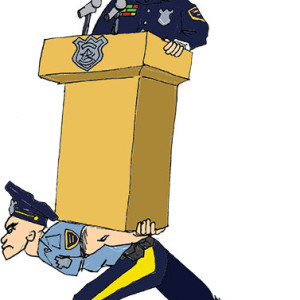The Last Run of Psychodog
By Tim Dees
Police service dogs, better known as K9s, generally avoid the “man’s best friend” label. They and their handlers prefer the dogs maintain a rep of ferocity and aggressiveness, the better to intimidate burglars and other assorted bad guys. Most law enforcement agencies acquire their K9s from breeders and trainers who specialize in this area. Candidate puppies are trained and conditioned from birth to be police K9s. Those that meet the requirements are eventually paired with a handler who comes to the training school so the new team can get acclimated to one another. Police departments pay many thousands of dollars for these dogs. My employer paid for only the bare essentials to equip the street grunts (police officers) in the Patrol Division, placing a higher priority on funding extended management courses for our administrators at places like Harvard and Oxford. Our K9s came mainly from the pound.
When the animal control director saw a possible candidate come through the gate, he would call the K9 sergeant, who would stop by for a look. If they were one of the appropriate breeds, gender (females weren’t deemed to be aggressive enough) and size, they might go home with a current or aspiring handler for a tryout. After a few months of training, the sergeant would proclaim the dog was “certified,” and the dog and hander went on patrol. No one could define exactly what it meant to be “certified,” except that the certificate was lifted if the dog screwed up too badly, or when they got too old to work after several years of service.
Police K9s enjoy a life rich with good experiences. They spend more than half the day with their handlers, most of that riding around in cars, barking at things that go by. They occasionally get to chase people who run from them, and if they catch them (they usually do), they get to knock them down and/or bite them. For dogs, this is better than sex. K9s sleep a lot less than most other dogs, and they tend to die relatively young form the dog equivalent of burning the candle at both ends, but you won’t find a happier dog.
When the dogs are among people familiar to them, they are as friendly as any other family dog. As the field training officer assigned to the K9 team, I made it a point to get familiar with all the dogs. If the handers resisted this idea, I reminded them I might have to pull them out of a wrecked patrol car someday, and it would be better if I didn’t have to first shoot the dog to do it. This held for King, Zack, Baron and the other German shepherds on the team, but not for Psychodog. If push came to shove, I was going to have to plug Psychodog.
Where the other K9s rode with their heads leaning out of the back door windows, drooling on the paint job, Psychodog (I do not remember his real name) saw the world from behind auto safety glass. This is because he lunged and snarled at everything that came within 50 feet of the car, and gouged grooves in the glass with his fangs. He hated me as much as everyone else he saw, except for his handler, Jeff. Jeff had convinced the sergeant Psychodog was up to the job, but the rest of us were skeptical.
Psychodog’s last caper began on a warm summer night, while I was alone in a diner, drinking coffee and trying to stay awake. Jeff and Psychodog were dispatched to a residential burglary in progress, but were some distance away from the location. I was considerably closer, and “bought” the call with my portable radio. Psychodog and Co. continued to roll to the incident.
As I drove to the neighborhood where the burglary was happening, I saw the other K9 patrol car behind me about six blocks. When I turned the corner onto the street where he had been dispatched, I saw what I had not expected to see: the burglar. He was standing in the middle of the otherwise deserted street, carrying a large toolbox he had just acquired. He matched the description given by the complainant perfectly.
I stopped my car with the interloper in the headlights, got out, drew my gun, and told him to put his hands on his head. He dropped the toolbox and complied. About this time, Jeff pulled up behind me, Psychodog barking and snarling continuously in the back seat. Jeff walked up on the passenger side of my car and told me he was “going hands on,” meaning he would approach and handcuff the suspect. I nodded for him to do so.
The burglar had other ideas. Seeing his last opportunity to remain a burglar instead of an inmate, he took off down the street. I immediately knew I couldn’t run that fast on the best day I ever had, and this was not that day. Jeff took off in pursuit, and decorum required that I accompany him.
I saw Jeff stab at his shirt pocket and remembered this was where the handlers carried a garden-variety garage door opener remote control. This remote operated the latch of one of the rear doors of the K9 car, which was spring-loaded to open when released. It became clear that Psychodog was loose and coming up behind the caboose of this little train, namely, me. About the time I was anticipating Psychodog’s jaws attaching to my ass, I saw the dog run past me toward Jeff, then pass Jeff in pursuit of the burglar. Although I was starting to come up short for air, my motivation was renewed. Seeing a police dog use a burglar as a chew toy is what cops regard as tops in entertainment, and I wanted an unobstructed view.
Psychodog was in thrall. He had lived his life for this moment. He reached the burglar, but instead of taking him down, he ran alongside, apparently thinking this was some new game. Surely, there would be snausages in the offing. The burglar hit the back yard fence of a residence, vaulted over the top, and was never seen again. Psychodog stopped at the fence and waited for his treat to materialize.
After performing a perfunctory search for the burglar and taking the report from the victim, I returned to the station, where our sergeant wanted the details. Whatever it took to be certified, Psychodog wasn’t anymore. I don’t know what became of him. If you ever come across a sedan with vertical grooves dug into the interior window glass, stand back. Psychodog may be inside.
Tim Dees is a retired police officer and the former editor of two major law enforcement websites who writes and consults on technology applications in criminal justice. He writes the “Police Gear and Tech” column for PoliceOne.com, and is the author of The Truth About Cops, published by Hyperink Press. He can be reached at tim@timdees.com.



